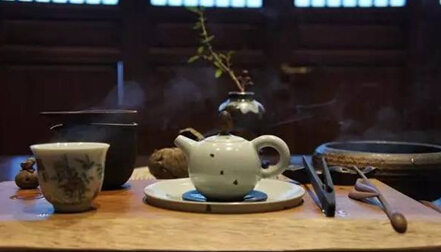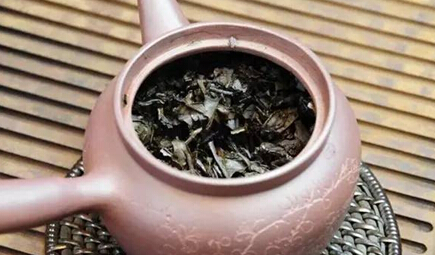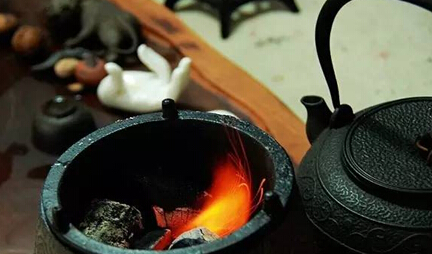Tea: Generally, older, well-aged tea leaves are more suitable for brewing by boiling, such as old White Tea, Hei Cha (Dark Tea), and aged Tieguanyin, etc."
[Main Text] Boiling tea can be divided into two methods: boiling directly and boiling after initial infusion. Lighter teas like White Tea and Tieguanyin, which are considered health-preserving drinks, are suitable for putting directly into a pot to boil. On the other hand, stronger teas like Pu-erh Tea are better suited to being infused in a gaiwan five or six times first before boiling. This prevents the brewed tea soup from becoming too strong.
1. White Tea
Belonging to the lightly fermented tea category, it uses tender buds and leaves with many white hairs on the back. These are dried by sunlight or gentle heat, resulting in a silvery-white appearance and the characteristic "green wrapped in white." As White Tea is not rolled during processing, the leaves remain complete and unfurl when brewed. The tea aroma is mellow and harmonious, and the liquor is light in color.
White Tea is suitable for simple, natural pottery tea sets and can be either decocted or infused.

2. Hei Cha (Dark Tea)
Hei Cha is a post-fermented tea. Because it uses relatively coarse raw material and undergoes a long process of pile-fermentation, it possesses a rich aged aroma, a mellow and thick taste, and the tea liquor often appears deep brown.
Hei Cha can be either infused or decocted. Using pottery tea sets takes advantage of their good adsorption properties to eliminate some off-flavors formed during fermentation and storage, making the aged aroma of Hei Cha more prominent. Furthermore, the rustic, bold nature of pottery complements Hei Cha, creating a simple and solemn feel that matches its profound aged charm.
3. Black Tea (Hong Cha)
The most internationally popular tea category, it is a fully fermented tea. It is made from the buds and leaves of the tea plant through typical processes including withering, rolling (cutting), fermentation, and drying. It is named Black Tea (Hong Cha) because the dry leaves and the brewed liquor are primarily red in hue.
Black Tea is suitable for both infusion and decoction. It can be drunk plain or blended. Drinking plain, without any additives, allows the tea to express its inherent fragrance. The plain drinking method is suitable for enjoying Gongfu Black Tea, focusing on appreciating its aroma and醇味 (mellow taste).

4. Oolong Tea
Qing Cha, also called Oolong Tea, belongs to the semi-fermented tea category. Oolong Tea has the strong, fresh taste of black tea and the fresh, fragrant aroma of Green Tea, uniquely characterized by "green leaves with red edges." It is suitable for brewing in Yixing clay teapots, which can absorb excess fire energy from the tea leaves, softening the vigorous nature of Oolong Tea. It is best paired with light-colored tasting cups to appreciate the tea liquor.
Oolong Tea can also be boiled, but it should not be decocted for too long. Otherwise, the tea liquor becomes too strong, affecting the taste. It is best boiled using earthenware or ceramic vessels.
5. Pu-erh Tea
Pu-erh Tea, also known as Dian Qing Tea, belongs to the Hei Cha (Dark Tea) category. It is named after Pu'er County, its original distribution and trading center. Pu-erh Tea uses Yunnan large-leaf sun-dried green tea as raw material and undergoes a sub-fermentation process. Based on different fermentation levels, it is divided into raw (sheng) and ripe (shou) types. The finished product is categorized into loose tea and compressed tea.
Weng Kun, Deputy Secretary-General of the National Tea Standardization Technical Committee and Associate Researcher at the National Tea Quality Supervision and Inspection Center, clearly stated: Pu-erh Tea is better infused; it is best not to boil it. Boiling Pu-erh can easily make it too concentrated, which not only increases the risk of insomnia at night but can also burden the spleen and stomach. Simultaneously, boiling makes it difficult to control the aroma and taste of Pu-erh. Only some coarse, aged teas can be boiled, but the boiling time should not be too long, preferably 3 to 5 minutes.

6. Green Tea
"Clear soup and green leaves, with a strong astringent taste" are the characteristics of Chinese Green Tea, and the requirements for tea ware are also the most particular and varied.
The water temperature for brewing should be determined by the tea. For high-grade Green Tea, especially tender bud Green Tea, the brewing water temperature should be controlled between 80°C and 90°C (176°F - 194°F). Water that is too hot can easily destroy vitamin C in the tea and cause more caffeine to leach out, resulting in a yellowish tea soup and a bitter taste. Therefore, tender bud Green Tea is not suitable for boiling.